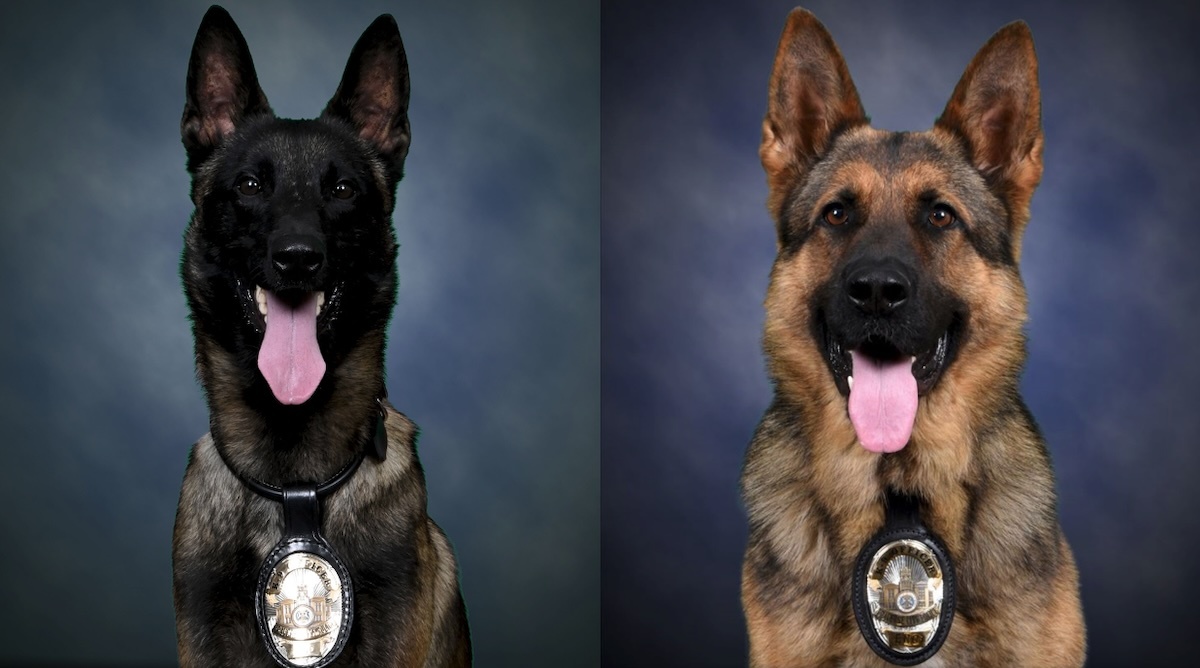
The Canines Behind the K-9 Units
A look at what it takes to become a police dog
By Anna Faller | Sept. 13, 2025
The American Kennel Club describes K-9 dogs as “a special type of dog. These impressive animals come from generations of dogs specifically bred to perform the complicated tasks that police dogs are required to accomplish.” Those tasks include search and rescue, detection of hazardous or illegal substances, and even apprehension of suspects with the help of their human counterparts.
Northern Express sat down with four local handlers to talk about training, tools, and tail-wagging success for K-9 units in northern Michigan. Meet:
- Officer Ben Snyder and K-9 Officer Kilo & Officer Logan Core and K-9 Officer Eno, both of Traverse City Police Department
- Sergeant Zach Hicks and K-9 Officer Attila of the Cadillac Police Department
- Sergeant Tyler Midyett and K-9 Officer Divot of the Emmet County Sheriff’s Office
Bred to Work
The first question when pursuing a four-legged officer is what kind of dog works best? Though every pooch has a unique set of strengths, there are select breeds whose high intelligence, trainability, and stamina predispose them for the meticulous work of law enforcement. These are the paradigmatic German Shepherd, Dutch Shepherds, and increasingly, the Belgian Malinois.
For context: the majority of American K-9 dogs are actually born and bred in European countries, like Germany, Belgium, and the Netherlands, whose pedigree lines and history of training “working” dogs goes back generations. Eno, Divot, and Attila are all German Shepherds, while Kilo is a Belgian Malinois.
“I’ll speak for every dog that I’ve trained with [when I say] that they’re happy to go to work,” says Traverse City Police Department K-9 handler Officer Ben Snyder. “They have the time of their lives doing what they do.”
These breeds also consistently outshine others in a testable area known as drive—aka a dog’s motivation to complete a task in order to obtain a reward like a ball, treats, or in the case of more than one local K-9, a favorite Kong toy. Generally speaking, Snyder notes, the greater that drive, the more efficient and reliable that dog will be when completing critical tasks in the field.
“They have to have the motivation to work,” he explains. “If we’re asking them to find a specific odor and they have no motivation to find it, they’re not going to be able to do the job we need them to do.”
Per Snyder, quick and well-muscled dogs like larger herding breeds, which can run up to 35 mph and have an estimated bite force of a whopping 200 pounds per square inch, also serve as valuable players in apprehension contexts. “[Kilo is] a great asset as force deterrent!” he adds.
Pairing Up
Once an office has selected the best-suited breed, the next step is for the dog-officer pair to complete a certification program, which are available through a number of accredited facilities throughout the state (Northern Michigan K-9 in Clare, for example, is common choice for local squads). These programs range from about five weeks to four months, depending on vendor and specific requirements, and can cost between $12,000 to $20,000 to complete.
From there, each handler is paired with a dog who enters the field at no younger than nine or 10 months, but could be as old as one or two years, and assuming they’re compatible, the duo puts their snouts to the grindstone learning new skills.
The first order of business is laying the groundwork for the person-to-pup partnership that will define the course of their shared career. Per Snyder, that bond is “inseparable,” built through a combination of initial hand-feeding, plenty of pets, and long hours spent together, all of which speak to the dog’s primal instincts by identifying the handler as their “pack” leader.
Synder says most of the K-9 puppies approved for training are also “semi-green,” which means they’ve already undergone basic obedience practice and have been imprinted, or trained to sniff out and identify, a target substance like drugs or explosives.
Divot of Emmet County, however, is unique in that she had no formal training prior to her coursework with Midyett. Though it does require more work from the handler, this can be advantageous for behavior training.
“I saw that imprinting process, so if I run into any problems on the road I can go back to square one to correct them,” Midyett explains.
Practice Makes Perfect
For dogs that have already completed imprinting, which is usually achieved by pairing correct detection with a high-value reward, much of the K-9 certification process surrounds communication between the dog and their human (think: learning to tactfully work a leash, laying paths for tracking, identifying alert signals, etc.) and honing the dog’s detection skills for as many real-world situations as possible.
“You never want your first time running into something new to be when you’re doing it live,” Midyett adds. “So, we always try to simulate those scenarios, because you never know how your dog’s going to act.”
To do this, handlers and their training K-9s work their way up through a series of “pictures,” which, per Snyder, is how dogs are best wired to learn.
Square one of this process involves teaching the dog to isolate their target scent in a context as simple as a box with a hole, before gradually adding layers of difficulty, like a person disguised in a sheet or a bite suit; new locations, like vehicles, buildings, or drawers; and a whole host of other scents to exclude, from the woods to water and beyond.
K-9s in the Field
Attila, Kilo, and Divot are narcotics specialists, which means their work could include car and residence searches, enacting warrants, or intercepting drug trafficking; while Eno, an explosives dog, locates dangerous objects, like pipe bombs, and responds to localized and “swatting” threat calls. However, K-9s are used to sniff out much more than drugs and explosives! Though finding or excluding substances is a key piece of what these dogs do in the field, all four are also patrol proficient.
In northern Michigan, common assignments can include trailing and tracking, wherein a K-9 officer follows their nose to locate a “walk away” individual—often a lost elderly person or child, but in some cases, a suspect fleeing a crime scene—as well as handler protection, apprehension, and even evidence recovery.
These are far from typical pet tasks, and completing them effectively and safely requires a stash of extra gear. In addition to the countless tracking harnesses, leashes, and other accessories, all four K-9 officers are also equipped with a fitted ballistic vest that’s approved for both bullet and puncture protection, a “buddy bag,” or specialized canine medical kit packed with stabilizing tools to address injuries sustained on the job, and an for the narcotics pups, a supply of doggy Narcan.
“There are always dangers wherever you go, so there are a lot of fail-safes we try to [have in place],” Hicks says.
Other K-9 safety gear often includes a GPS or tracking device, which handlers can attach to a dog vest or leash, allowing local dispatchers to keep live tabs on the team’s whereabouts—an especially handy tool for rural locations. Vehicle upgrades are also standard, including customized kennels for transport and an automated door system that releases the hounds at the press of a button.
Retirement Age
Even the most driven eventually age out of law enforcement. None of our squads report a formal cutoff, though Snyder notes that some agencies operate on a five-year maximum for K-9s.
Nevertheless, it’s fairly standard for police pups to retire between the ages of seven and 10, assuming they haven’t experienced any serious injuries or the hip dysplasia that plagues German Shepherds. Telltale signs that a furry officer is approaching the end of their K-9 career include slower pace and mobility issues.
The goal is to find the balance between retiring a still-spry dog too early and allowing them to enjoy the healthy and pampered golden years they deserve.
“It just goes back to the dog’s mentality,” Core notes. “If he loves going to work and he’s not slowing down, he can work as long as he wants!”
Trending

Farm to Glass with Ethanology
When Elk Rapids distillery Ethanology committed to locally-sourced ingredients for their products, it seemed like they&rsquo… Read More >>
MRKT HLDY SHPPNG, aka Warehouse MRKT Holiday Shopping!
Shop the latest from local makers and vendors at the Holiday MRKT Share at Warehouse MRKT in TC, Saturday, Dec. 20, from 10a… Read More >>
Men and Ugly Sweaters
Those two things don’t always go together, but on Dec. 19, you’ll see both out and about in Petoskey and Harbor … Read More >>


